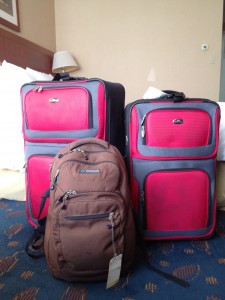Today I’m on the plane from Minneapolis to Washington, DC, the first leg of my journey to Africa, where I’ll be visiting Ethiopia and Tanzania.
Twenty years ago, I traveled to Africa for the first time, a few months after graduating from college. Everything was new to me then: the shots and pills for yellow fever, typhoid, malaria, and other tropical diseases; packing long sausage duffel bags with everything I thought I might need for a year of living in a tent; the long flights in which the trans-Atlantic flight to Europe was just a step along the way; trying to learn the basics of Swahili, a language that has somehow gained a reputation for being easy despite having half a dozen different noun classes and totally different grammar and vocabulary from European languages.
Back in 1992, I studied olive baboons at the Mpala Research Camp in the highlands northwest of Mount Kenya. Since then, I’ve spent about a third of my life in Africa. After ten months studying baboons in Kenya, I’ve spent years studying chimpanzees in Uganda and Tanzania. This summer, I’m returning to Gombe National Park in Tanzania, but first I’m traveling to a place that’s new to me: Guassa, in Ethiopia.
My graduate students are working at each of these sites. At Gombe, Lisa is studying food-associated calls of chimpanzees, and Andrea is studying sexual coercion among olive baboons at Gombe. I’ll be traveling to Guassa with Tyler, who will be studying intergroup aggression in gelada monkeys.
Packing for Africa this time involves packing for two totally different climates.
Gombe and Guassa both lie on the Great Rift Valley, a vast set of connected trenches that stretches 3,700 miles from Mozambique to Syria. That’s about as far as going from La Paz, at the southern tip of Baja California, all the way to Fairbanks, Alaska.
This steep, narrow, deep, long valley results from the forces of plate tectonics tearing Africa apart. Eventually, the Horn of Africa will become a big island off the coast of the rest of Africa, just as Madagascar peeled off from Africa some 135 million years ago.
Parts of this valley are underwater: the Dead Sea in Israel, the Red Sea, and the African Great Lakes.
Gombe stands on the edge of a flooded portion of the Great Rift Valley: Lake Tanganyika, the longest and second deepest lake in the world. The Great Lakes of North America pale in comparison to the African Great Lakes. Right now I’m flying over Lake Michigan, which is an impressive body of water, and it parts is over 900 feet deep. Lake Tanganyika, however, is nearly a mile deep, second only to Lake Baikal in Siberia (another rift valley lake).
People often ask me if it’s hot in Africa. What’s hard to grasp is just how huge and varied Africa is. Sure, some parts of it are hot – just like some parts of North America are hot. Getting off the plane in Dar es Salaam, on the east coast of Tanzania, the heat and humidity hit you like a wall.
But Africa is big enough to hold all of the United States, China, India, Japan, and much of Europe. It stretches from a bit further north than Nashville to as far south as Buenos Aires. And much of equatorial Africa lies on high plateaus, which are much cooler than the coastal lowlands.
At the lakeshore, Gombe is 780 m above sea level (about half a mile), and rises steeply up the rift escarpment to peaks up to 1,623 m (over a mile high). The temperature is pleasant year-round. Guassa, on the other hand, is over 3,000 m – over two miles high. From what I hear, it’s cold up there!
I know what I need to pack for Gombe: t-shirts, army surplus fatigues, Kosovo soccer cleats (the best shoes for keeping a person from sliding down the steep hills), and a waistpack for fieldwork, and swimsuit, fins, snorkel and mask for swimming in the lake.
But I’m less sure of what to pack for Guassa. The list of suggested field clothes includes a short-sleeved t-shirt, a long-sleeved t-shirt, a fleece jacket, a wind-proof jacket, raingear, long pants, long underwear, wool hat, a broad-rimmed white hat to go over that (apparently the gelada monkeys know that researchers wear white hats and are therefore safe to approach), and waterproof gumboots.
In the end I packed two suitcases: a big one for Guassa, and a smaller one for Gombe. I hope I’ve got what I need!

